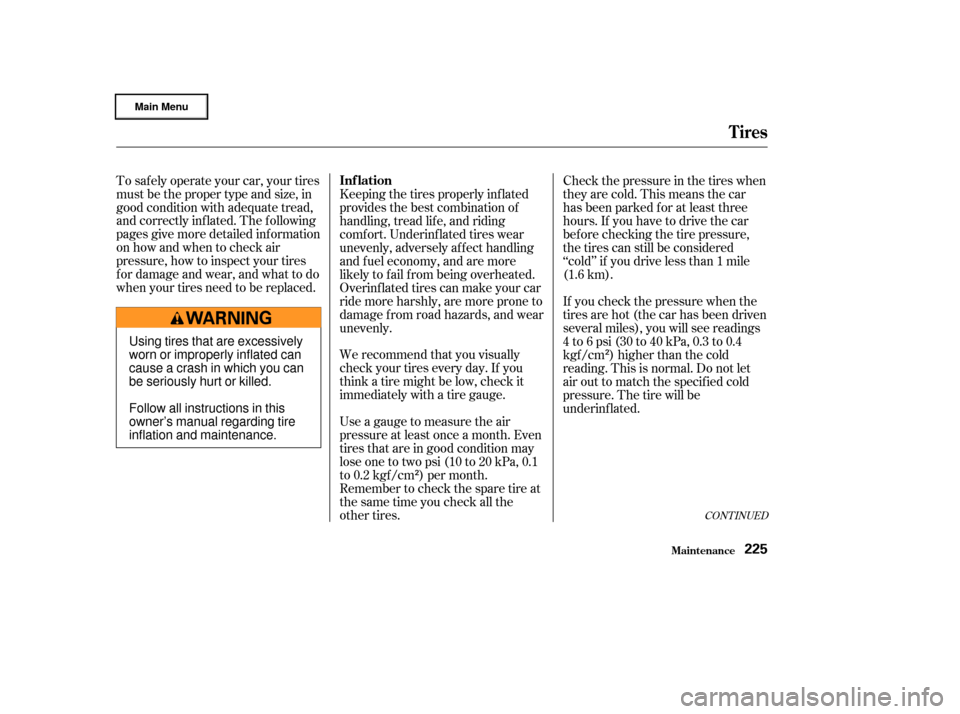Page 228 of 317

We recommend that you visually
check your tires every day. If you
think a tire might be low, check it
immediately with a tire gauge.
To saf ely operate your car, your tires
must be the proper type and size, in
good condition with adequate tread,
and correctly inf lated. The f ollowing
pages give more detailed inf ormation
on how and when to check air
pressure, how to inspect your tires
for damage and wear, and what to do
when your tires need to be replaced.
Keeping the tires properly inf lated
provides the best combination of
handling, tread lif e, and riding
comf ort. Underinf lated tires wear
unevenly, adversely af f ect handling
and f uel economy, and are more
likely to f ail f rom being overheated.
Overinf lated tires can make your car
ride more harshly, are more prone to
damage f rom road hazards, and wear
unevenly.
Use a gauge to measure the air
pressure at least once a month. Even
tires that are in good condition may
lose one to two psi (10 to 20 kPa, 0.1
to 0.2 kgf /cm ) per month.
Remember to check the spare tire at
thesametimeyoucheckallthe
other tires.Check the pressure in the tires when
they are cold. This means the car
has been parked f or at least three
hours. If you have to drive the car
bef ore checking the tire pressure,
the tires can still be considered
‘‘cold’’ if you drive less than 1 mile
(1.6 km).
If you check the pressure when the
tires are hot (the car has been driven
several miles), you will see readings
4 to 6 psi (30 to 40 kPa, 0.3 to 0.4
kgf /cm ) higher than the cold
reading. This is normal. Do not let
air out to match the specified cold
pressure. The tire will be
underinf lated.
CONT INUED
Inf lation
Tires
Maint enance225
Using tires that are excessively
worn or improperly inflated can
cause a crash in which you can
be seriously hurt or killed.
Follow all instructions in this
owner’s manual regarding tire
inflation and maintenance.
Page 229 of 317

When you return to normal speed
driving, be sure to readjust the tire
pressure f or normal driving. You
should wait until the tires are cold
bef ore adjusting the tire pressure. Honda strongly recommends that
you not drive f aster than posted
speed limits and conditions allow. If
you decide it is safe to drive at high
speeds, be sure to adjust the cold tire
pressuresasshowninthenext
column. If you do not adjust the tire
pressure, excessive heat can build up
and cause sudden tire f ailure.
The following chart shows the
recommended cold tire pressures f or
most normal driving conditions and
speeds.
Thecompactsparetirepressureis:
These pressures are also given on
thetireinformationlabelonthe
driver’s doorjamb.
Tubeless tires have some ability to
self -seal if they are punctured.
However, because leakage is of ten
very slow, you should look closely
for punctures if a tire starts losing
pressure.
Youshouldgetyourowntire
pressure gauge and use it whenever
you check your tire pressures. This
will make it easier f or you to tell if a
pressure loss is due to a tire problem
and not due to a variation between
gauges.
Tire Size
Cold Tire Pressure
for Speeds over 100
mph (160 km/h)
Tire Size Cold Tire Pressure
for Normal Driving
Tires
Maint enance
T ire Pressure A djust ment f or HighSpeed Driving
Recommended T ire Pressures f or
Normal Driving
226
60 psi (420 kPa , 4.2 kgf/cm)
P185/70R14 87S 30 psi (210 kPa , 2.1
kgf/cm
)
P185/70R14 87S 35 psi (240 kPa , 2.4kgf/cm
)
Page 258 of 317

This section covers the more-
common problems that motorists
experience with their vehicles. It
gives you inf ormation about how to
safely evaluate the problem and what
to do to correct it. If the problem has
stranded you on the side of the road,
you may be able to get going again.
If not, you will also f ind instructions
on getting your car towed.......................
Compact Spare Tire .256
....................
Changing a Flat Tire .257
..........
If Your Engine Won’t Start . 263
Nothing Happens or the Starter Motor Operates Very .....................................
Slowly .263
The Starter Operates ................................
Normally .264
................................
Jump Starting .265
............
If Your Engine Overheats . 268
.........
Low Oil Pressure Indicator . 271
..........
Charging System Indicator . 272
.......
Malf unction Indicator Lamp . 273
.......................
Readiness Codes .274
...............
Brake System Indicator . 275
..............................................
Fuses .276
..........
Checking and Replacing . 277
......................
Emergency Towing .282
Taking Care of the Unexpected
T aking Care of t he Unexpect ed255
Page 259 of 317

Follow these precautions whenever
you are using the compact spare tire:Thecompactsparetirehasashorter
tread lif e than a regular tire. Replace
it when you can see the tread wear
indicator bars. The replacement
should be the same size and design
tire, mounted on the same wheel.
Thecompactsparetireisnot
designed to be mounted on a regular
wheel, and the compact wheel is not
designed f or mounting a regular tire.
Check the inf lation pressure of the
compact spare tire every time you
check the other tires. It should be
inf lated to:
Do not exceed 50 mph (80 km/h)
under any circumstances.
This tire gives a harsher ride and
less traction on some road sur-
f aces than the regular tire. Use
greater caution while driving on
this tire.
Do not mount snow chains on the
compact spare.
Your car has a compact spare tire
that takes up less space. Use this
sparetireasatemporaryreplace-
ment only. Get your regular tire
repaired or replaced and put it back
on your car as soon as you can.
The wheel of the compact spare
tire is designed especially to f it
your car. Do not use your spare
tire on another vehicle unless it is
thesamemakeandmodel.
Compact Spare Tire
T aking Care of t he Unexpect ed256
INDICATOR LOCATION MARK
TREAD WEAR INDICATOR BAR
60 psi (420 kPa , 4.2 kgf/cm)
Page 261 of 317
Loosen the f our wheel nuts 1/2
turn with the wheel wrench.
Turn the jack’s end bracket
counterclockwise to loosen it, then
remove the jack.
Open the trunk. Raise the trunk
f loor mat and the trunk f loor by
lif ting up on the back edge.
Take the tool kit out of the trunk.
Unscrew the wing bolt and take
the spare tire out of its well. 6.
7.
3.
4.
5.
T aking Care of t he Unexpect ed
Changing a Flat T ire
258
SPARE TIRE TRUNK FLOOR
TOOL KIT JACKJACK
WHEEL WRENCH
Page 263 of 317
Lowerthecartothegroundand
remove the jack.
Put on the spare tire. Put the
wheel nuts back on f inger-tight,
then tighten them in a crisscross
pattern with the wheel wrench
until the wheel is f irmly against
the hub. Do not try to tighten
them f ully.
Bef ore mounting the spare tire,
wipeanydirtoff themounting
surface of the wheel and hub with
a clean cloth. Wipe the hub
carefully,itmaybehotfrom
driving.
11.
12.
13.
T aking Care of t he Unexpect ed
Changing a Flat T ire
260
BRAKE HUB
Page 264 of 317
Tighten the wheel nuts securely in
the same crisscross pattern. Have
the wheel nut torque checked at
the nearest automotive service
f acility.
Tighten the wheel nuts to:Place the flat tire face down in the
spare tire well.
Remove the center cap before
storing the f lat tire in the spare
tire well. Wrap the spacer cone and spare
tire wing bolt with cloth or paper
and store them in the spare tire
well.
14. 16.
15. 17.
CONT INUED
Changing a Flat T ire
T aking Care of t he Unexpect ed261
CENTER CAP
80 lbf·ft (108 N·m , 11 kgf·m)
Page 292 of 317

�µ�µ�µ
�µ
�µ
�µ
�µ
�µ
�µ
�µ
�µ
�µ
�µ
�µ
�µ
�µ
�µ
�Î
�Î
�Î
�Î
Specif ications
T echnical Inf ormation289
Fuses
Alignment
Air Conditioning
Lights
Battery
Tires
HFC-134a (R-134a)
17.6 19.4 oz (500 550 g) SP-10
12 V
12 V 60/55 W (HB2)
21/5 W
12 V 8 W 12 V 3 CP
12 V 21 W
12 V 3 CP
12 V 21 W 12 V 21/5 W 12 V 21 W
12 V 3 CP Interior
Under-hood
Toe-in
Camber
Caster
2°20’1°
0°12’
0.00 in (0.0 mm)
P185/70R14 87S
Refrigerant type
Charge quantity
Lubricant oil type
0.08 in (2.0 mm)
12 V
12 V 8W
5W
Headlights (HI/LO)
Front turn signal/side marker
lights
Front parking light
Rear turn signal lights
Stop/Taillights/Rear side
marker lights
Back-up lights
Taillights
High-mount brake light
License plate lights
Ceiling light
Spotlights
Trunk light
Capacity
12 V 35 AH/20 HR See page
281or the fuse label
attached to the inside of the fuse
box door under the steering
column.
See page 280or the fuse box
cover.
T115/70D14 88M
30 psi (210 kPa , 2.1 kgf/cm
)
60 psi (420 kPa , 4.2 kgf/cm)
Size
Pressure
T125/70D15 95M
Front
Rear
Front
Rear
Front
Front/Rear
Spare
Front/Rear
Spare
1 : Without ABS
2 : With ABS
1
2